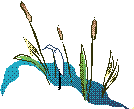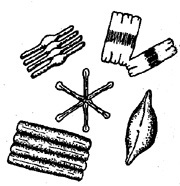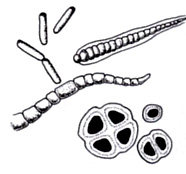Key Characteristics of Lakes and Ponds
- Lakes and ponds are formed by remnants of glaciers, blocked rivers, and rivers that fill natural basins.
 - Inland wetlands form as lakes and ponds slowly dry up. The soil is supersaturated with water, and there are small areas of still or slow moving water. - Inland wetlands form as lakes and ponds slowly dry up. The soil is supersaturated with water, and there are small areas of still or slow moving water.
- In lakes, ponds, and inland wetlands, the water is standing, not flowing. Though currents can be swift as waters enter and leave ponds and lakes, in general, ponds and lakes move slowly because they have been blocked (by beaver dams, humans, natural rock cavities, etc.)
- The water in lakes, ponds and inland wetlands is layered (stratified) according to temperature, oxygen and life.
- The bottoms of lakes, ponds and inland wetlands are covered with mud that includes the decaying bodies of dead plants and other organisms. The older the body of water, the more mud there is at the bottom.
 - The shoreline of lakes, ponds and inland wetlands contains an abundance of life. These areas, like the shorelines of oceans, are nurseries for fish and crustaceans. The plants here filter pollutants running off the land. Older ponds and lakes have larger littoral zones around the edges. - The shoreline of lakes, ponds and inland wetlands contains an abundance of life. These areas, like the shorelines of oceans, are nurseries for fish and crustaceans. The plants here filter pollutants running off the land. Older ponds and lakes have larger littoral zones around the edges.
|
Stratification
Temperature stratification
Ponds and lakes are usually stratified because they stand relatively still, compared with streams and rivers. You may remember swimming in a pond or lake where the surface water was warm but you could feel the cooler water beneath. Typically the coldest layers are found at the bottom.
Changing temperatures in the spring and fall prevent stratification during those seasons, and the bottom waters irsing to the top stir up nutrients. In the spring, ice warms and melts. As this water warms from 0 degrees C to 4 degrees C, it becomes denser and sinks, pushing the bottom wares upwards. This causes the layers to mix. In the fall the waters become colder. As the water temperatures drop below 4 degrees C, the colder layers rise to the top, and again the whole body of water is mixed.
Oxygen Stratification
The amount of dissolved oxygen is usually highest near the surface of the water, where oxygen can diffuse across the air-water interface. However, the amount of dissolved oxygen varies quite a bit as the result of differences in temperature, sunlight, wind and the number of plants at various depths.
Some fish are bioindicators of the amount of oxygen in the lake and pond layers. Fast-moving fish (such as trout) need a lot of oxygen, whereas slow-moving fish (such as catfish) can survive in areas with lower dissolved oxygen levels.
Biotic (Producer-Consumer) Stratification
In general, more producers are found near the top, and more consumers near the bottom of the water. Producers require sunlight near the surface of the water for photosynthesis. The bottom layers contain consumers such as anaerobic bacteria and decomposers.
The biotic stratification in lakes, ponds and wetaands typically consists of three layers or zones. They are:
- limnetic – open water near the surface that receives a lot of sub; this region is inhabited by photosynthesizers, including phytoplankton (diatoms, desmids) and zooplankton (rotifers, copepods, and others).
- profundal – deep open water; this region is too deep for photosynthesis to occur and this has limited life.
- benthic – bottom; this region is inhabited by decomposers and anaerobic bacteria. |
How Lakes and Ponds Age (Sucession)
Ponds and lakes age just as animals and plants. Over time, lakes and ponds fill with dead material and begin to dry up, forming wetlands. The average lifetime of a pond is close to 100 years, though human impact tends to accelerate the aging process.
As lakes or ponds age, organic materials builds up on the bottom, The organic material causes eutrophification, gradually using up the available oxygen. This older lakes and ponds take on swamp-like characteristics and produce methane.
The age of a lake or pond can be identified using bioindicators. Types of phytoplankton (microscopic plat forms) and algae are good indicators of the relative age of a pond or lake.
 - Desmids, geometric-shaped green algae, are good indicators of young bodies ofwater. These organisms prefer low nutrient areas, high oxygen levels, and low turbidity (particles suspended in water. - Desmids, geometric-shaped green algae, are good indicators of young bodies ofwater. These organisms prefer low nutrient areas, high oxygen levels, and low turbidity (particles suspended in water.
 - As the body of water ages, the desmids are replaced by the diatoms, which are golden colored and also have geometric shapes. - As the body of water ages, the desmids are replaced by the diatoms, which are golden colored and also have geometric shapes.
 - When the body of water enters the eutrophic stage, blue-green algae begin to dominate the population. - When the body of water enters the eutrophic stage, blue-green algae begin to dominate the population.
|
 - Inland wetlands form as lakes and ponds slowly dry up. The soil is supersaturated with water, and there are small areas of still or slow moving water.
- Inland wetlands form as lakes and ponds slowly dry up. The soil is supersaturated with water, and there are small areas of still or slow moving water.  - The shoreline of lakes, ponds and inland wetlands contains an abundance of life. These areas, like the shorelines of oceans, are nurseries for fish and crustaceans. The plants here filter pollutants running off the land. Older ponds and lakes have larger littoral zones around the edges.
- The shoreline of lakes, ponds and inland wetlands contains an abundance of life. These areas, like the shorelines of oceans, are nurseries for fish and crustaceans. The plants here filter pollutants running off the land. Older ponds and lakes have larger littoral zones around the edges.  - Desmids, geometric-shaped green algae, are good indicators of young bodies ofwater. These organisms prefer low nutrient areas, high oxygen levels, and low turbidity (particles suspended in water.
- Desmids, geometric-shaped green algae, are good indicators of young bodies ofwater. These organisms prefer low nutrient areas, high oxygen levels, and low turbidity (particles suspended in water.
 - As the body of water ages, the desmids are replaced by the diatoms, which are golden colored and also have geometric shapes.
- As the body of water ages, the desmids are replaced by the diatoms, which are golden colored and also have geometric shapes.  - When the body of water enters the eutrophic stage, blue-green algae begin to dominate the population.
- When the body of water enters the eutrophic stage, blue-green algae begin to dominate the population.